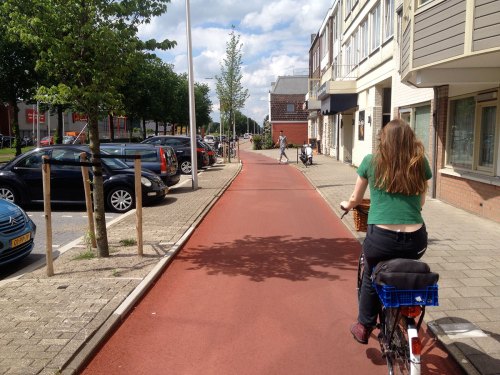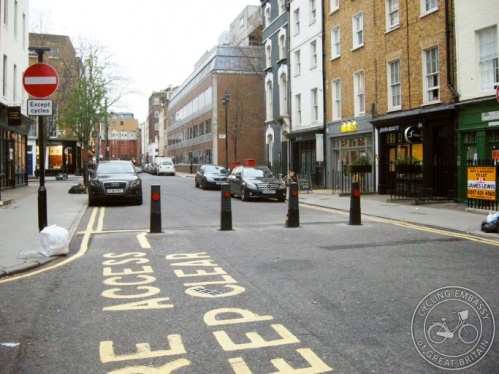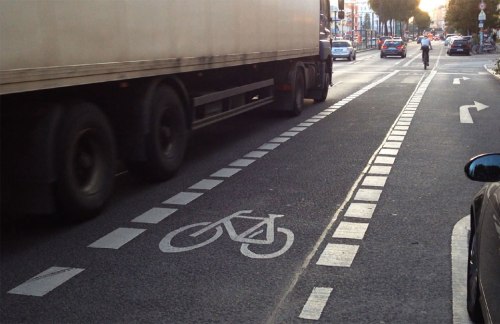This article was originally published on my German blog, but it may well be of interest to my English readers, so here it is.
It concerns the obsession that many German cycle campaigners have with the law which makes many cycleways mandatory to use. It’s known in German as ‘Benutzungspflicht’ – don’t try to pronounce it – but I’ll refer to it as the ‘Pflicht’ in this English version, because “usage obligation” sounds rather cumbersome.
There’s a lot of noise made about the Pflicht here, a bit like how liability legislation or the effectiveness of vehicular cycling is hyped up out of all proportion in the UK. Campaigners would achieve far better results if they focussed instead on what actually works.
Unfortunately the comments on the German post are largely divided into people who believe the Pflicht is a terrible thing for cycling which must be removed immediately, and people who believe the Pflicht is the only thing which is keeping the German cycleways from being ripped out altogether. Few seem to agree with my suggestion that it’s largely irrelevant and that we should concentrate on demanding great cycling infrastructure.
By the way, I’ve got permission to translate lots of great English-language blog posts, so if you know German (no need to be perfect, we can clean it up before publishing) and have the time and inclination to do some translating, then please do get in touch.
The Pflicht (German law making most cycleways mandatory to use) is not what holds back cycling in Germany. Bad cycling infrastructure is the cause of Germany’s lacklustre cycling rate.
Firstly, let me say that I understand why so many hate the Pflicht, and why many also oppose the concept of cycleways. Most cycleways in my city of Berlin are awful, truly dire – narrow, bumpy strips squeezed onto the edge of the footway. That’s not a cycleway, it’s an insult, and it’s unreasonable to compel people to use such rubbish.
But the oft-suggested solution to this problem – to demand an end to cycleways and to gain the right to ride on the carriageway – isn’t really a solution at all. It merely swaps one set of problems for another.
Even for fast, confident cyclists, removing the Pflicht will not suddenly make drivers behave nicely, just as plenty of other rules are ignored by people using any mode of transport. Taking down that round blue sign won’t change attitudes towards cyclists on the road, and it’s not a step towards safer cycling for all.
It’s also very exclusionary: there are huge numbers of people for whom cycling amongst motor vehicles simply can’t work. Children, seniors, people with disabilities – they all have the right to fast, efficient transport too. On-road cycling is clearly not a mass transport solution.

Lifting the compulsory use regulation will not change this busy road into a comfortable or safe cycling environment.
Could the Pflicht even be a good thing?
The two most successful cycling countries on the planet have a Pflicht. That’s right: our neighbours the Netherlands and Denmark both have compulsory-use cycleways.
And nobody in those countries questions it. Why would you want to cycle on the road amongst dangerous, pollution-spewing cars and vans, when you can use smooth, wide cycleways instead? (The key point here being that they’re good quality.)
Conversely, my home country of Great Britain has no Pflicht at all. It never has done.
That’s right, it’s a dream come true for German cycling activists – British cyclists have the legal right to use the road, just as the driver of a car does. Surely Britain must be a cycling paradise! Surely cars are outnumbered by bikes even more than in Dutch towns!
Well the answer is no, not even close.
Cycling in the UK is almost without exception awful. It’s considered to be stressful and dangerous, something that only a fit, healthy and slightly eccentric few actually bother doing. The very concept of cycling has been reduced to an extreme sport that only enthusiasts bother with, and it’s generally spoken of in derisive terms. It’s hard to express how low the status of cycling is in the UK. Cycling for practical reasons almost doesn’t exist in most of the country.

The Netherlands is clearly the success story, and the UK isn’t. So why would we want to copy what the UK has done?
The graph above is based on this graph which showed more countries, but I’ve simplified it to show only the countries I’m familiar with.
The Pflicht clearly correlates with a higher cycling rate and lower death rate. Of course other factors also play a role, but it could be argued that the Pflicht actually increases the cycling rate, and makes cycling safer. That’s not my contention, however the Pflicht clearly doesn’t harm cycling rates.
What the graph definitely does show is that the Pflicht is, at worst, an irrelevance with regards to more and safer cycling. The two lead nations for cycling both have a Pflicht, but as they also have good cycling infrastructure, it’s not an issue. You’ll search long and hard to find many Dutch or Danish cycle campaigners demanding the right to cycle on the road. (They do campaign for improvements to cycleways, however.)
The UK, conversely, has no real cycling infrastructure to speak of, except for painted cycle lanes on the road, which are ubiquitous. The right to cycle on the road hasn’t aided cycling in the UK one bit. Quite the opposite, in fact: once cycling on the road is the design goal, traffic engineers can effectively ignore cycling altogether. It becomes obsolete, a historic footnote.

Yes, everyone – children, the elderly, and everyone in between – has the right to cycle here. Funny, that so few people choose to exercise that right.
And that’s exactly what will happen here too, if Germany’s cycle campaigns get their wish and cycling on the carriageway becomes the norm. Most people who use a bike for transport simply don’t want to cycle amongst motor traffic (most Germans choose to use even very poor quality cycleways rather than ride amongst motor traffic).
Cycling is never made more pleasant, safer or more convenient by the addition of motor vehicles. If the only option is to mix with motor traffic, then people will vote with their feet and abandon cycling, as happened in Britain.
The oil and motor industries must be rubbing their hands with glee when they see how so many cycle campaigners are asking for the very thing that will kill cycling off.
Cycling is too good for the carriageway
Cycling is a great mode of transport, especially in cities. It’s clean and fast, it goes directly from starting point to destination, takes just seconds to set off and to park. It’s egalitarian, suitable for people of all types, ages and abilities. It presents very little danger to the user, and compared to motoring it presents very little danger to others.
Cycling is far too important a mode of transport to be mixed in with motoring. Motor vehicles are polluting and dangerous, their queues hold everyone up, and they take ages to manoeuvre and park. How does cycling benefit from being mixed up with all that? Cycling has inherently positive qualities, which are negated by both poor-quality cycleways and by on-road cycling.

Cycling deserves much better than to be mixed up with motor traffic. The queues which are an inherent problem of motor vehicles do nothing to benefit cycling.
Cycling shouldn’t merely be provided for. It solves or alleviates so many problems in cities that it deserves to be prioritised and favoured, to play to its strengths, and to make it the most convenient and obvious choice for those journeys to which it is suited. It needs be treated as a distinct mode of transport, important enough for its own place in the street – not something to be squeezed on to the footway, nor thrown in amongst the motor vehicles.
More cycling benefits everyone (except the oil companies) so journeys by bike should be a top transport priority for the authorities responsible for transport. Even people not cycling benefit from increased cycling, as there’s fewer traffic jams, cleaner air, fewer fatal crashes and less crowding on public transport. Conversely, more driving harms everyone – more pollution, more queues, more crashes, injuries and deaths.
The only proven way to genuinely promote cycling is to campaign for real space for cycling. This means real cycleways – call them cycle-roads if you want – along main roads. Back streets should all be mode-filtered to prevent them being used as through-routes by motor vehicle (bollards and/or one-way restrictions achieve this). This needs network-level planning, not disjointed bits and pieces.

Cycling must be treated as a real, important, and distinct mode of transport. It mustn’t be treated merely as fast walking or slow driving.
Cycling should be a key part of public transport policy. Merely asking for it to be treated like driving – awkwardly thrown into sharing space with cumbersome, dangerous machinery – will only lead to less cycling, as the UK has so clearly demonstrated.
We must follow the leader, look to the Netherlands for the best examples (and keep a critical eye on the poorer stuff). We should talk about cycling like the great mode of transport it really is, and demand that it be treated with the priority it deserves.
If cycling advocates won’t demand the best, who will?

When cycling is treated properly, then all sections of society have access to this fast, healthy and cheap form of transportation.











 The Alternative Department for Transport is written by, and the personal opinion of,
The Alternative Department for Transport is written by, and the personal opinion of, 


